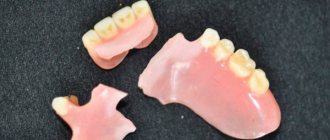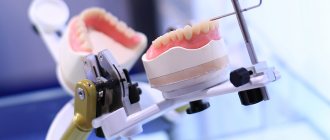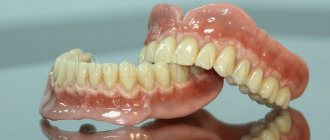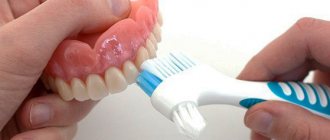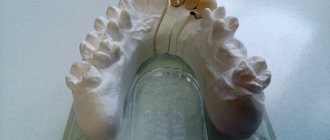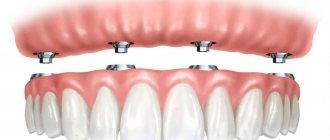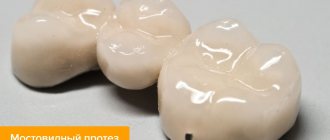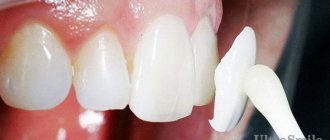948
Biologically passive thermoplastics of medical purity are increasingly being used for the manufacture of artificial organs and individual body structures.
The most famous and most popular thermoplastic for creating the basis for removable dentures is polyamide, patented under the Deflex brand.
Polyamide is developed by the Argentine company NUTEN as a material for the manufacture of the base of removable structures.
Features of the material
Deflex is a polyamide with a high elasticity index, which allows this material to be classified as a semi-rigid thermoplastic.
This feature gives polyamide significant advantages, and puts prostheses based on it an order of magnitude higher than nylon analogues in many characteristics.
Thus, the material has increased temperature stability , and reacts completely differently to temperature changes. Deflex, as is usually the case with nylon, does not harden when eating cold foods and does not soften when eating hot foods.
The simultaneous combination of the maximum density of polyamide with its minimum porosity provides high levels of strength, stability and durability of prosthetic products based on it.
And the low absorption of all kinds of liquids blocks the formation and fixation of bacterial plaque on the surface , the appearance of odor, and prevents distortion of the color of the structure.
The increased strength and elasticity of the material makes it possible to make a device whose thickness will be at least half that of acrylic, which guarantees it comfort when wearing, lightness, and preservation of the patient’s natural phonetics.
In addition, with such characteristics it was possible to distribute the chewing load evenly, prevent the formation of a shoulder load on the supporting elements and ensure the vertical stability of the entire structure.
Polyamide is a hypoallergenic material , which means it is ideal for patients who are prone to all kinds of allergic manifestations. Deflex is also distinguished by its natural transparency, which makes products based on it completely invisible.
Important! A unique combination of creation technology and material allows us to produce a functional prosthesis with ideal aesthetics. Such products comply with the Kennedy classification, combining 5 main functional properties - stability, support, retention, bending and occlusion.
The first signs of an allergy to dentures and ways to get rid of the problem.
Visit here to learn more about contraindications for removable dentures.
At this address https://www.vash-dentist.ru/protezirovanie/semnyie-p/vidyi-klammerov.html we will consider the types of retaining clasps.
How does a soft prosthesis work?
Structurally, it consists of three main elements:
- a translucent flexible base - an artificial analogue of the gum, matching it in color;
- invisible nylon hook-clasps, providing reliable fastening of the prosthesis to the gingival part of the supporting teeth;
- artificial teeth made of metal-ceramic or plastic and welded to a base.
Due to the softness of nylon, a removable denture does not injure the oral mucosa at all, and its fastenings do not damage tooth enamel. Thanks to staining with a hypoallergenic dye, the base of the prosthesis completely merges with the tissues of the oral cavity. The shade of artificial teeth is matched to the natural one, so the aesthetics of prosthetics are beyond praise: even a partial nylon structure adjacent to the patient’s natural teeth is absolutely invisible in the mouth.
Areas of use
The area of use of polyamide prostheses is quite wide. It is appropriate to install such products in patients with the following indications:
- minor defects in the dentition, when 1-2 elements are missing;
- edentia, i.e. not a single tooth survived;
- allergic reaction to metal alloys.
Deflex dentures are also successfully used for patients suffering from periodontal disease or periodontitis, since there are no conditions for loosening of supporting teeth.
It is also advisable to recommend them to those for whom preparation is strictly contraindicated.
Polyamide structures are ideal for people who have traumatic professions, for example, firefighters, police officers, athletes, etc., since it is almost impossible to break them.
It is also recommended to choose Deflex for people who, due to certain restrictions, are contraindicated for implantation.
Such pathological conditions include:
- heart failure;
- thyroid problems;
- immune system diseases;
- hepatitis;
- diabetes;
- blood diseases.
Contraindications
Important! Removable devices, including polyamide ones, have virtually no contraindications for use.
They should not be worn by people suffering from:
- pathologies of bone tissue;
- mental disorders;
- oncology;
- acute or chronic inflammatory diseases in the body.
It is also not recommended to install them if you are depressed, pregnant, drug addicted, or undergoing radiation therapy.
Why dentures may become loose and what specialists are doing.
In this publication you will find detailed information on the adequate selection of abutment teeth.
Here https://www.vash-dentist.ru/protezirovanie/semnyie-p/raznovidnosti-bazisov-zubnyih.html all the most important things about creating the basis of a partial removable denture.
Advantages and disadvantages
To understand all the features of the new generation designs, it is necessary to name their main advantages.
These products, in comparison with analog products made from other materials, have the following qualities:
- Adequately distributes the chewing load.
- Not subject to change due to temperature fluctuations.
- Stable in the oral cavity.
- They have good suction to the gums and retention, i.e. Fixed perfectly to the palate and gums.
- They have a short adaptation period.
- They do not cause discomfort to the gums and soft tissues, which means they do not cause irritation.
- Comfortable to use as they are light in weight.
- Durable and easy to care for, do not require the use of special cleaning agents.
- If the operating rules are followed, the dentures do not break. Microcracks do not form on their surface if accidentally dropped.
- They are not absorbed by intraoral fluids or odors and retain their original color.
- Shows perfect aesthetics.
- They do not change the taste perception of food.
Important! Polyamide prostheses under the Deflex brand do not have the disadvantages that are inherent in analogue products made from acrylic or nylon.
The disadvantages of the structures under consideration are isolated. It should be noted:
- High cost. Not all patients can afford to install a polyamide prosthesis, so the selection of the design should be done with a specialist, taking into account all the features of the clinical case.
- Little fame. Since the material is new and has been used in dentistry relatively recently, not all clinics can offer their clients products based on it.
- Impossibility of repairs. In the event of a breakdown, polyamide devices cannot be repaired (glued or welded) and will require re-prosthetics.
Zirconium crowns are the future that has come to us today
We produce crowns with filigree precision. We use CAD\CAM computer technology, which protects against inaccuracies when scanning the impression.
Advantages of zirconium crowns over metal-ceramics
- 100% natural aesthetic appearance. This is facilitated by an ideal subgingival fit. The edge of the gum remains pink and looks natural. The zirconium base is white and does not show through the translucent enamel.
- We produce crowns with filigree precision. We use CAD\CAM computer technology, which protects against inaccuracies when scanning the impression.
- Zirconium is stronger than metal alloys. At the same time, the zirconium prosthesis is two times lighter. This improves the quality of the fit.
- Zirconium is a hypoallergenic material. It does not cause irritation to adjacent tissues.
- The ceramic coating is identical to the properties of a living tooth and looks aesthetically pleasing. The crown cannot be distinguished from a natural one.
- If there are no contraindications, the nerve can be preserved under the crown, which will allow the tooth to remain alive.
The production time for a zirconium dioxide crown or bridge in our CAD\CAM laboratory is five days. During production, we will install temporary crowns for you.
Sign up for a consultation
Installation steps
The manufacture and installation of any model of removable systems is faster and easier than non-removable products. The entire process of restoring missing teeth can be divided into 2 stages: clinical and laboratory.
The clinical stage includes the following activities:
- Study of anamnesis . The doctor interviews the patient about his state of health, living conditions and occupation, studies his medical record in detail, and also finds out whether he has had experience with prosthetics and how comfortable the device was.
- Instrumental examination of the oral cavity, which determines the condition of the mucous membrane, remaining dental units, chewing muscles, and the quality of oral hygiene.
The sensitivity of teeth is assessed, the symptoms of dental pathologies are identified and the degree of their severity is determined. - Hardware examination of the dental system. Before prosthetics, CT (computed tomography), orthopantomogram, radiovisiography, MRI are used
- MRI (magnetic resonance imaging). The results are necessary to determine the limitations or indications for prosthetics, the choice of technique for restoring the dentition and the type of structure.
Thanks to a complete examination of the dental system, a specialist can identify hidden dental pathologies, obtain information about the quality, density and volume of the jaw bone, the condition of the alveoli, dental roots, periodontal tissues and the temporal joint. - Preparing the oral cavity . Hygienic cleaning, removal of remaining roots that cannot be restored and impacted dental elements, and treatment of identified pathologies (inflammation, caries, etc.) are required.
- Selecting a removable device model. Taking into account the number of remaining teeth, the condition of the oral cavity, and the location of the defect, the orthopedic dentist selects a design model.
- Receiving an impression. Using silicone or alginate mass, an impression of both jaw arches is made.
After the impression arrives at the laboratory, the laboratory stage of prosthetics begins. The entire creation process takes place in the following sequence:
- The impression technician casts models of both jaws (entirely or only certain areas), from which the prosthetic product will later be made.
- The specimens are secured so that the position corresponds to the patient's centric occlusion. To avoid making mistakes, an occlusal roller is made, which is sent to the dentist to determine the patient’s occlusion.
- The model is fixed on the articulator. In this position, a model of the future prosthesis is cast from plaster. The cushion is removed and artificial teeth are placed in its place.
- The sample is sent for the first fitting , during which the correct selection of the shade of artificial teeth to real ones and the accuracy of closure of the jaw arches are tested.
- Fit. After checking, the model is returned to the laboratory, where the technician, taking into account all the comments, forms the final version of the design.
The finished product is tried on again for the patient. It should fit perfectly in all respects. If deficiencies are found, the design must be adjusted.
Watch the video to see how the Deflex prosthesis is made.
Price issue
In large clinics, the cost of restoring teeth with a complete Deflex denture varies from 40 to 70 thousand rubles. The final price depends on the following points:
- the amount of treatment performed before installation;
- method of fastening the structure;
- specialist qualification;
- status and pricing policy of the clinic.
Partial models will naturally be 15-25 thousand rubles cheaper. A design that will replace only 1-3 teeth costs no more than 15 thousand rubles.
Ceramic inlays - microprosthetics
Microprosthetics using ceramic inlays is a new direction in dentistry, the purpose of which is to preserve severely damaged teeth.
The photo shows the process of microprosthetics with ceramic inlays.
Sign up for a consultation
Reviews
Deflex polyamide prostheses are new and are still little known. But their use in dental restoration allows one to avoid the disadvantages that are characteristic of analogue structures made of nylon or acrylic.
You can talk about your experience of restoring missing teeth using Deflex dentures and your impressions of them by leaving a comment on this article.
If you find an error, please select a piece of text and press Ctrl+Enter.
Tags prosthetics removable dentures
Did you like the article? stay tuned
Previous article
For what purposes are temporary dental implants used?
Next article
Treatment of dental anomalies using the Schwartz apparatus
Prosthetics on implants
At the Unit clinic, we install dental implants made of nanotitanium, which independently adapt to the surrounding tissues, enhancing integration with the bone.
Sign up for a consultation
